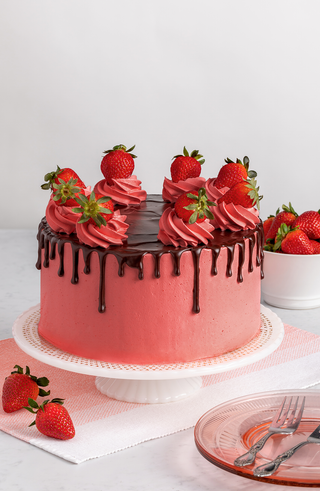
Subscribe and stay updated
Easter Basket Cake - Tip by Tip
Easter Basket Cake - Tip by Tip
Rated 5.0 stars by 1 users
Author:
@cakeandcuddleco
This cake was such a fun one to make—a full-on Easter basket vibe, made completely with piping tips from Kootek! And yes, I used whipped cream for the whole thing, but if you're more of a buttercream decorator, every single one of these techniques works just the same.
Whether you're brand new to piping or just need some inspo for your next cake, here's a behind-the-scenes breakdown of how I brought this cake to life, step by step.
This cake is 100% piped—no fondant, no molds, just basic tips and technique. Whether you're decorating with whipped cream or buttercream, you can use this same setup for birthdays, spring celebrations, or just a fun weekend cake project.

Ingredients
-
Whipped cream
Directions
Top Tier: The Carrot Patch
This top tier is playful and fun, covered in little carrots and topped with a soft pink shell border.
Tip K02 – Carrots
For the carrots, I started at the bottom of each one and piped side-to-side in a zigzag motion, moving upward in slightly wider strokes to build a cone shape. I used medium pressure to get those ridges to show up clearly.
Tip K20 – Carrot Leaves
Each carrot got 2–3 short, overlapping pulls upward to form the leafy tops. I held the piping bag at an angle, and giving pressure to the bag piped each leaf. You don’t want these to look flat—so don’t rush. Press firmly to create volume, then flick upward.
You can make your green cream a bit firmer for sharper leaves.
Tip K36 – Top Border (Shells)
Instead of piping a single line of shells or stacking two rows, I alternated the placement of each shell—one slightly toward the outside edge, the next a little inward, and kept repeating that pattern around the top. This creates a wavy, dimensional border that looks fuller and more playful than a standard shell line. It almost gives the illusion of a ruffle, and it's perfect for tucking in sprinkles or decorations like mini eggs.
Tip K05 – Base Border (Top Tier)
At the base of this tier, I added a row of small pink rosettes. I used a piping bag held upright, started in the center, and piped a simple swirl outward in a clockwise motion. These make the transition between tiers look intentional and pretty.
Bottom Tier: Basket Base & Blooms
The bottom tier combines texture and floral details to mimic a spring basket full of flowers and eggs.
Tip K04 – Basketweave
This one looks fancy but is actually super easy once you get the rhythm. I started with a vertical line as my base. Then I piped evenly spaced horizontal strips across it. After that, I piped the next vertical line overlapping slightly, then repeated the horizontal strips in the blank spaces.
Tip: Use a turntable if you have one—it helps keep the pattern even. And use chilled whipped cream or firm buttercream for sharp edges.
Tip K26 – Large Rosettes
I placed these large pink rosettes right above the basketweave layer. Hold your piping bag upright, start in the center, and do one full swirl around. Don’t lift until the swirl is finished.
These big blooms are what make the whole cake feel like a flower basket.
Tip K05 – Small Rosettes
I filled in the gaps between the large rosettes with smaller ones using the same swirl motion. This adds fullness and makes the design feel complete without overcrowding.
Tip K23 – Leaves
To add greenery, I piped short, pulled leaf shapes around the rosettes. I angled the bag just slightly and used a firm squeeze to get a nice pointed end.
Don’t skip the leaves—they really make the flowers stand out.
Details That Bring It All Together
Speckled Effect: I used a tiny food-safe brush and edible paint ( just cocoa mixed with water) and flicked it gently over the cake. It adds a fun Easter-egg texture to both tiers.
Chocolate Eggs: I added chocolate eggs around the rosettes for an extra festive pop. You can also use mini macarons, meringues, or fondant decorations depending on the look you want.
Buttercream or Whipped Cream?
This cake was decorated entirely with stabilized whipped cream, but if you prefer buttercream, every technique works just the same with buttercream.
Chill the cake before piping if possible—it helps every detail stay sharp.
Recipe Video
- Choosing a selection results in a full page refresh.
ABOUT US
CONTACT US
GET IN TOUCH
© 2025, Kootek All rights reserved.
